
Monument Valley: Is it a valley? A wide flat plateau? Or a desolate landscape that remains a living testament to the sandstone layers that once covered the region? Known to the Navajo as Tsé Biiʼ Ndzisgaii, Monument Valley exemplifies the images that generations of moviegoers identify as the American West.

The 1969 movie “Easy Rider”, suggested that an unapologetic sense of individualism and dirt covered freedom could be found exploring the southwest on a motorcycle. Twenty-five years later, Forrest Gump’s three-year, coast to coast, cathartic run, found an unexpected finish line in Monument Valley.

For me, the most poignant film that features and defines Monument Valley is the documentary “The Return Of The Navajo Boy.” This internationally acclaimed documentary reunites a Navajo family and triggered a federal investigation into uranium contamination on Navajo lands.
In the 1940’s, government surveyors discovered large deposits of uranium in Monument Valley. Between 1944 and 1986, nearly four million tons of ore were extracted from Navajo lands, in an attempt to fuel the Cold War nuclear arms race. At the end of the war, the mining companies moved out and the highly toxic contaminated sites remained. Over time, the ore pits filled with water, providing a contaminated community water source to unsuspecting Navajos.

Twenty-first century Monument Valley remains an overwhelming landscape that offers a master class in surreal geometry, impeccable architecture, and human resilience. As a visitor, it’s a place I wanted to explore in the off-season, away from the crowds, tourists, and the tour buses. It’s a place where I wanted to taste the dirt!

Just after sunrise, the Perfect Stranger, Shadow, and I left Vermilion Cliffs bound for GooseNecks State Park, Utah. Our five-hour drive had no set agenda, outside of trying to capture the spirit of Monument Valley.

After crossing the Navajo Bridge, we followed Highway 89 before heading east on Highway 160. The Arizona section of this highway lies entirely within the Navajo Nation.

On the outskirts of Tuba City, a roadside water tank and windmill caught our eye. Without hesitation, we pulled over and the Perfect Stranger scaled the Aermotor windmill.

Climbing and photographing water tanks had become an official past time for us both.


Leaving Tuba City, we continued along Highway 160 towards Kayenta.

A few miles south of town, a rock formation stood out in the distance.

In order to get a closer look, the Perfect Stranger and I impulsively followed a dirt road that branched off the main highway. This is one of the many attributes I appreciate about the Perfect Stranger, her spontaneity and her willingness to explore undeveloped back roads.
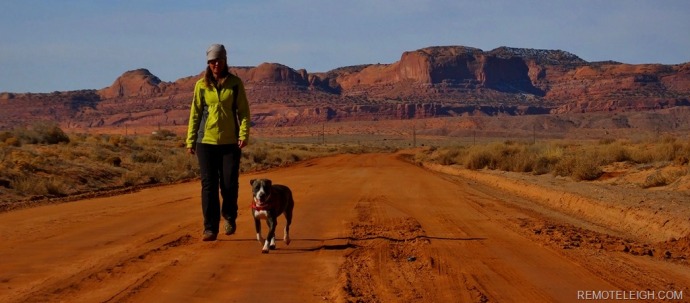
The dusty dirt road was littered with abandoned car tires, mattresses, sheet metal, glass bottles, and household appliances.
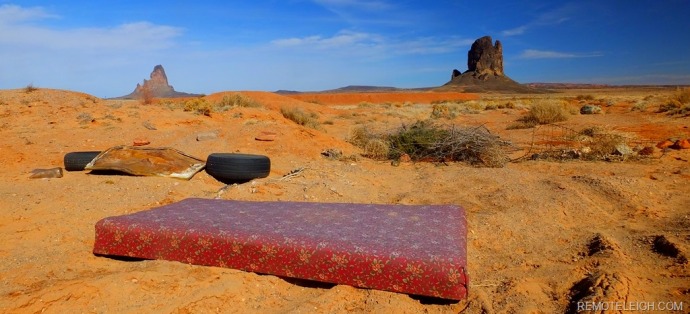
Trash collection is an ongoing problem on tribal lands. The Navajo Nation does not have landfills or recycling plants; instead, they have overflowing waste transfer stations. In theory, the Navajo pay to have their trash picked up and transported to transfer stations, where it’s then hauled away to landfills in bordering towns. In practice, garbage trucks won’t drive on the unmaintained reservation dirt roads, making trash dumping an unsustainable option to an unsolved problem. I think many people would be shocked to know that many tribes still lack the basic services of running water and electricity.
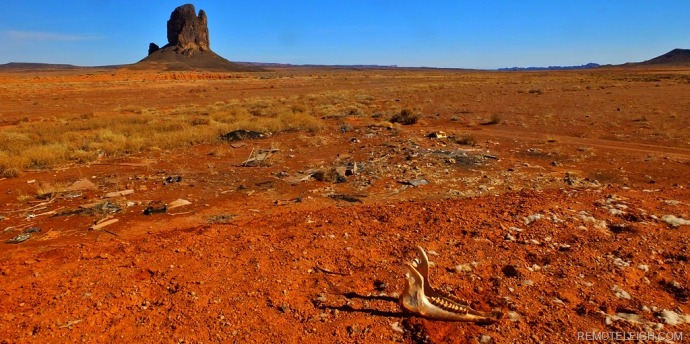
Despite the trash, we walked across the barren desert floor towards the volcanic rock formation.

It was during this walk that I noticed Shadow’s bond with the Perfect Stranger. Like his mama, Shadow had fallen for her. Capturing their relationship through my camera lens made it even more magical.The pictures clearly demonstrated his adoration and willingness to follow her direction.
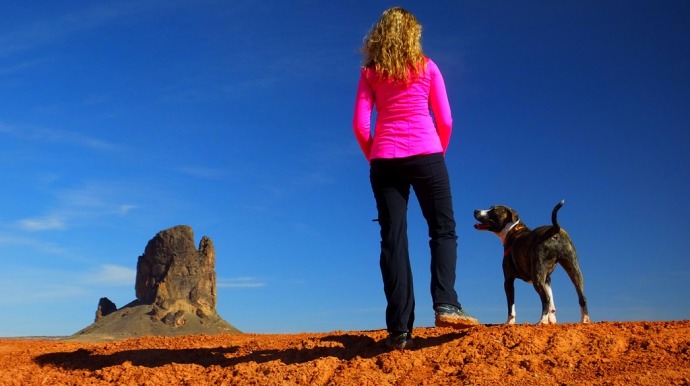

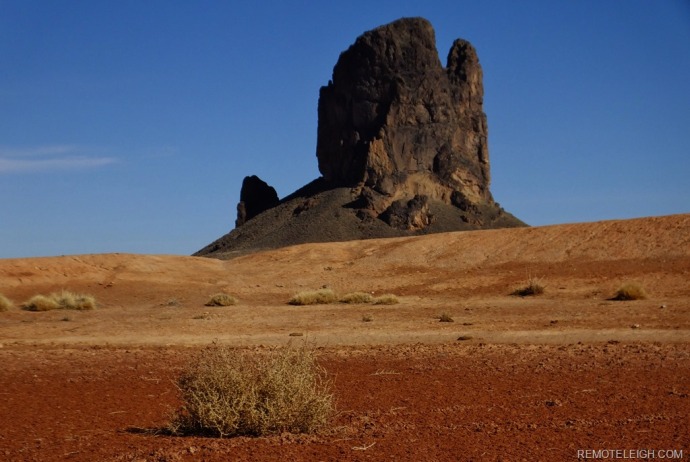
Realizing that we were still seventy miles from camp, the Perfect Stranger and I made our way back to the car. Seventy miles seems like a minimal distance to cover; however, between our impromptu stops and my pet peeve of setting up camp in the dark, we were mindful of the remaining daylight hours.

Leaving highway 160, we headed north on Highway 163. Twenty-three miles separated us from Monument Valley and the nation’s fastest growing county, San Juan County.

Gaining over a thousand residents between 2015 and 2016, this remote southeastern portion of Utah grew 7.6%. What inspired the migration to San Juan county? With an unemployment rate of almost 10%, it’s safe to say, people are not moving to the county for job opportunities.

Could tribal members be moving back to the Navajo Nation reservation due to oil field jobs drying up in other states? Is the affordability of the county attracting retirees? Has tourism impacted the county’s growth? Will Bears Ears National Monument create further growth due to tourism and employment opportunities? Only time will tell if the population growth will improve the living conditions and employment opportunities for the residents of the state’s poorest county.

Crossing the state line, we were greeted by a “Welcome to Utah, Life Elevated” billboard. Upon closer inspection, the sign had been covered in various unrelated stickers. It made me wonder, how did this sticker phenomenon happen? Who’s idea was it? Are stickers the new form of sign tagging for tourists? With no stickers in our possession, we were content to focus on desert scape that stood before us.

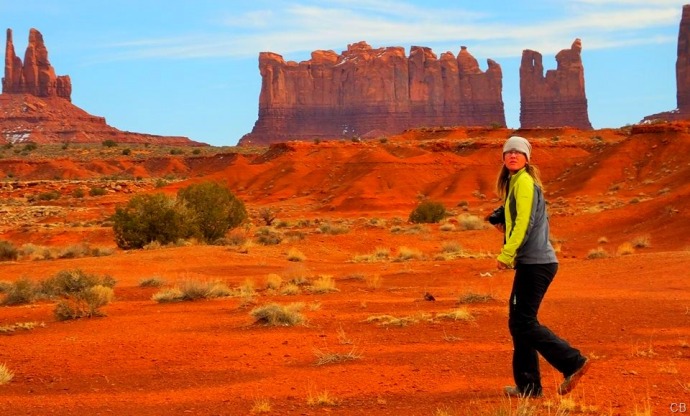
On the other side of the highway, a hitchhiker heading south caught my attention.

Being off-season, there was very little traffic; I wondered how many miles he would have to walk before getting a ride. Based on his gear, I could tell he wasn’t a thru- hiker; I regret not crossing the highway and saying “HI”.
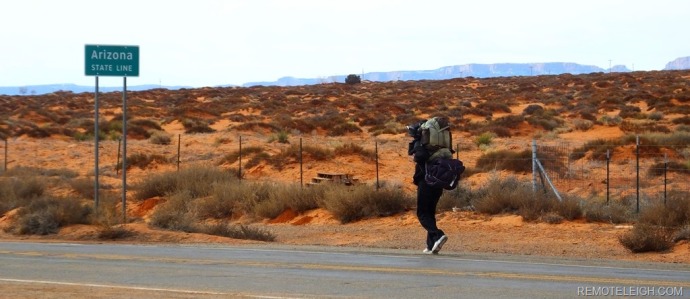
The remaining thirty-two-mile drive from Monument Valley to GooseNecks State Park was eventful as it was scenic.


On road trips, the Perfect Stranger and I are in a constant search for the ‘the shot’. To us, the shot that captures the personality of the landscape. The shot that elicits a feeling of awestruck. The shot that makes a creative’s empty stomach feel full. The shot that’s a once in a lifetime time, never to be repeated.

The Perfect Stranger caught a glimpse of ‘the Monument Valley shot’ in our rearview mirror. We immediately pulled over on the outskirts of Halchita, grabbing our cameras, to hike up the gully and along the plateau to our destination.

Before we could even start taking pictures, miraculously the Perfect Stranger spotted a ravenous pack of rez dogs three plateaus over. Rez dogs are feral dogs that roam tribal lands left to fend for themselves. Rez dogs must compete for food, shelter, and water. Killing livestock and attacking humans occurs with alarming regularity on the reservation.
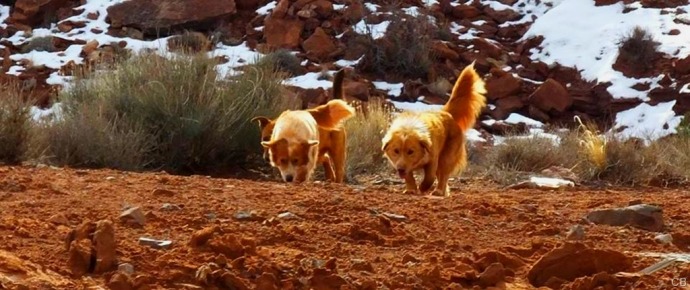
We saw them before they smelled us. Were we standing down wind preventing our human scent from traveling to their sensitive noses? A quick mental calculation told the Perfect Stranger we had had three gullies between us and five sets of rez dog teeth. Behind us lay a 200 yard sprint to the safety of the car. Could we make it back the car before the rez dogs fanned out, circling us and cutting off our retreat? Would Shadow follow our direction and sprint to the car? We knew in our heads if Shadow noticed the rez dogs he would instinctively try to protect us from the pack resulting in his death. The Perfect Stranger and I shared a glance in that moment, silently communicating that it was time to run for our lives. Every year, over three thousand dog bites and attacks are treated on Navajo Nation. We had no intention of becoming another statistic!
With a two gully headstart, the Perfect Stranger, Shadow, and I hightailed it to the car. Five rez dogs who looked like Benji but possessed the temperant of Kujo, fanned out in pursuit. Still recovering from bruised ribs, I was the slowest runner of the group. The Perfect Stranger kept Shadow engaged to prevent him from realizing that a pack of rez dogs was chasing us. With one gully to spare, we reached the safety of our car. For the rez dogs, the pursuit was not over until the last car door slammed shut. With our adrenaline in overdrive, we breathed a sigh of relief, silently acknowledging just how close we had come. We never did get “the shot”!

Addressing and resolving the plight of rez dogs is a very complex issue. There are no immediate fix-its or long term solutions. How does the Navajo Nation preserve it’s traditional culture while managing the modern realities of dog overpopulation? An estimated 445,000 stray dogs live within the Navajo Nation. Over three thousand people are treated every year for dog bites and attacks. From an animal control perspective: there are only six animal control officers and four active shelters, serving 25,000 square miles within the Navajo Nation. In addition to the lack of animal control enforcement, there is also a lack of veterinary care. Considering the high levels of poverty on the reservation, vaccinating and spay/neutering services are unaffordable. Cultural barriers and government mistrust have impeded efforts by rescue groups to offer spay/neuter programs on tribal lands. The documentary, “Rez Dogs”, takes an honest look at the problem from within. To watch the movie click here –
http://www.ya-native.com/Culture_SouthWest/video/rezdogs.html
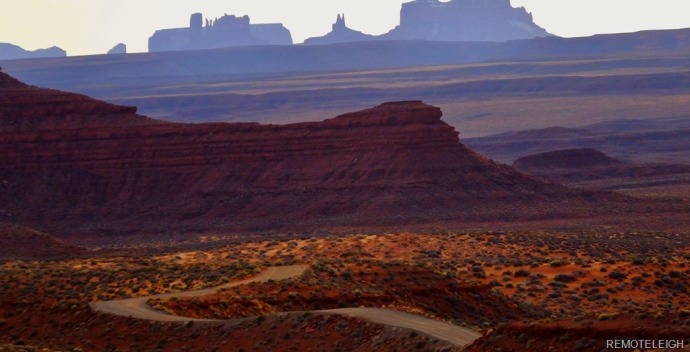
Leaving the eroded mesas of Monument Valley, we crossed the San Juan River and made a brief stop in Mexican Hat, Utah. This small town is named after the rock formation that resembles a sombrero.

With two hours left before sunset, the Perfect Stranger, Shadow, and I arrived at Goosenecks State Park. Our day had been one of windmills, water tanks, monumental walks, and a near death experience with rez dogs.
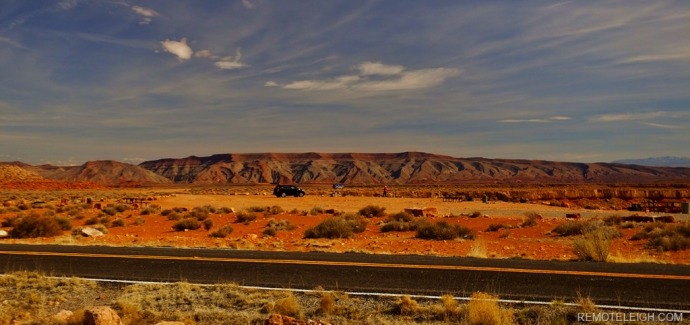

Before setting up camp, the Perfect Stranger and I inhaled three hundred million years of geological activity and caught our breath to one of the most impressive examples of an entrenched river meander.

For the next two days, this would be our playground. I was confident we would get another chance at the shot!
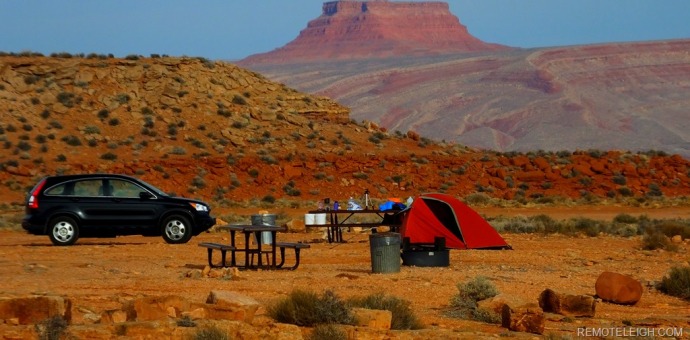
Such a beautiful landscape with such incredible pictures. This is the reason why I would love to visit the US. The nature is incredible.
LikeLike
thank you so much! Yes, America is incredibly diverse in it’s landscapes, flora, and fauna.
LikeLike
Wow, Monument Valley is just incredible to look at. I had no idea about the rez dog problem on Navajo lands, but your close encounter would have terrified me had I been there. At least you knew better than to try and befriend them and made it back safely. Hope the rest of your trip was wonderful!
LikeLiked by 1 person
Yes, Monument is as rich in landscapes as it is in history. The Rez dog issue continues to be a problem without a solution sadly. Cheers.
LikeLike
So cool how many classics have been shot here! Looks like a great place for a road trip 🙂
LikeLiked by 1 person
Looks amazing place.. but very rural though.. Did you have any problem there? Is it safe for tent camping?
LikeLiked by 1 person
only problem was with rez dogs. great camping at Goosenecks State Park.
LikeLike
Yes, very rural, no problems there outside of our rez dog incident. Plenty of places to tent camp safely.
LikeLike
These photos are beautiful and really inspiring me to make the US my next big adventure! Arizona is well up on my bucket list and this post is just inching it up further and further!
LikeLike
The photos look so nice, I thought it was from another planet. They are otherwordly. And at the same time, perfect for camping and roadtrips.
LikeLiked by 1 person
I was just in Monument Valley recently, myself. It is sort of overshadowed by some of the other stuff in the area, but I really loved it there. Not only is the desert so lovely, but as you point out, there is also some really interesting pop culture history here (not to mention Native American history). It is such a magical place.
LikeLiked by 1 person
These photos are incredible! I’ve always wanted to go to Moab and Zion and all that area around Utah. So good for climbing and base jumping!!!
LikeLiked by 1 person
What an amazing place to visit, I’ve added it to my U.S list and my bucket list.
LikeLike